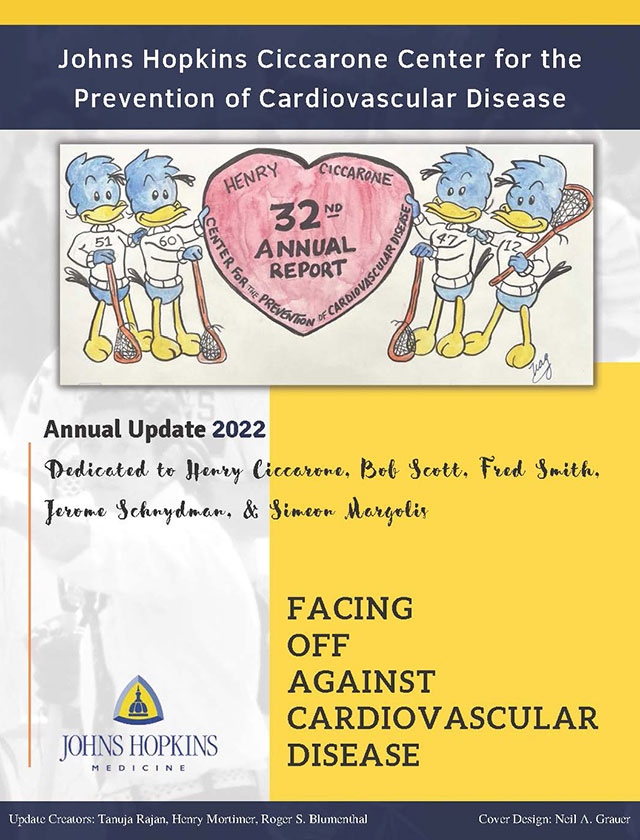The Ciccarone Center for the Prevention of Cardiovascular Disease
Our multidisciplinary center provides education and treatment for patients at high risk for developing cardiovascular disease.
Schedule An Appointment Schedule An Appointment
Schedule online through MyChart
Current Johns Hopkins Medicine patients: Log into MyChart and schedule online

Schedule by phone
New and existing patients: 443-997-0270

New Guidelines for Preventing Heart Disease
The American Heart Association and the American College of Cardiology has issued new national guidelines for preventing cardiovascular disease and stroke. Some of the guidelines include:
-
Learn more about the new prevention guidelines as we address frequently asked questions:
Q: How were the latest American Heart Association/American College of Cardiology guidelines developed?
A: It was a rigorous scientific process, probably the most rigorous guidelines ever written for preventing cardiovascular disease. Doctors, nurses and researchers—all members (but not employees) of the American Heart Association and the American College of Cardiology—read hundreds of existing studies. To be included in the final report, the science had to be done correctly, use high-quality data and give evidence-based advice.
Q: What's the purpose of the guidelines?
A: The guidelines were published to give doctors better ways to assess your risk and work with you to stay healthy. They are less about easy bullet points and more about looking at your whole picture—age, health, diet, exercise and other factors such as smoking and cholesterol.
Q: So the guidelines are really for doctors, not patients?
A: Both groups can take home a lot from this work. For patients, the new guidelines are more holistic; they look at the bigger picture, so you're not just focusing on a single behavior like cutting out fat.
But the trouble with advice for consumers is that it has to be general. That's why these new guidelines are geared toward health practitioners. We now have a set of tools to assess risk for each person, and that helps us customize a plan for our patients.
Q: What's new or different about these guidelines?
A: The guidelines now help doctors evaluate your risk of stroke as well as heart disease. And they account for the difference in risk between Caucasians and African-Americans.
Also, the conversation about diet is better developed. Instead of just advising people to lower their total fat intake, the guidelines discuss lowering sugars and processed foods and increasing fiber, fruits and vegetables. They also recommend adding more whole grains and healthy fats, such as olive oil and nuts, and eating lean proteins, with less red meat and more fish.
Q: What are the basics of the guidelines for consumers?
A: There are actually six different guidelines, and your doctor will help you tailor them to your situation.
Learn your risk. Your doctor will discuss this from multiple angles, including your race and gender. You can get a good estimate of your risk of a heart attack or stroke over the next decade and over the next 30 years.
- Maintain a healthy weight. Your body mass index (BMI) should be normal (below 25) and certainly not obese (over 30). The guidelines give good, practical suggestions on how to improve your BMI.
- Get your cholesterol numbers in line. Aim for a higher HDL and low total cholesterol.
- Eat vegetables and fruits, whole grains, lean protein and healthy fats like olive oil and nuts. Avoid most saturated fat, simple sugars and processed foods.
- Exercise regularly. Talk to your doctor about how much aerobic and strength-training activity you need each week.
- Don't smoke. If you currently smoke, ask your doctor about how to stop.
Q: Aren't the guidelines controversial?
A: There's a lot of discussion around the role of fats in our diet. Some people think carbs, not saturated fats, are the enemy. In fact, we are still learning about the way we process some foods. But the best science we have today still says the more fruits, vegetables and fiber you eat, the lower your risk of heart attack and stroke.
Second, the new risk calculator may overestimate your true risk of heart attack and stroke over the next decade. Ongoing research on the cost-effectiveness of coronary calcium scans and cardiac CT scans, as well as the use of blood tests for biomarkers other than cholesterol, will be very informative.
Q: Are the new guidelines really an improvement?
A: These are a significant improvement over prior guidelines, because they target better lifestyle habits, the cornerstone of prevention. Selective use of medication may also significantly decrease your risk of a major cardiovascular event.
-
Stroke has now been added as a predictor for cardiovascular disease:
For the first time, the guidelines added stroke to the equations for predicting future risk of cardiovascular disease. Recent studies have shown that women often suffer a stroke rather than a heart attack as their first consequence of cardiovascular disease.The guidelines emphasize looking at a person’s risk of a heart attack or stroke within the next ten years. The risk is calculated using the following factors: age, sex, race, total cholesterol and high-density lipoprotein (HDL—the “good” form of cholesterol), blood pressure and control of high blood pressure, diabetes and whether the person is a current smoker.
Risk factors are now placed in the perspective of each patient's condition:
- The guidelines emphasize chronological age; however, people age differently and “health age” may not correlate with chronological age.
- The guidelines do not take into account family history of early heart disease, which may increase a person’s risk. However, the committee recommends looking into family history if there is uncertainty about treatment decisions.
- A computed tomography (CT) scan to see if the person has evidence of coronary artery calcium can be a tie-breaker for helping to decide if a person should start statin medication therapy.
- If a person recently diagnosed with diabetes has normal cholesterol levels and a hemoglobin A1C measurement of less than 7.5 percent, then a coronary calcium scan can also help determine whether statin therapy should be started.
- Other tests that can help with decision-making about statins include a blood test for C-reactive protein (a marker for inflammation) and an ultrasound to assess blockages in leg arteries.
Determine your risk with a trained medical professional:
Remember that only a trained medical professional can determine your future risk of cardiovascular disease and develop an effective health plan. -
The guidelines recommended that more adults discuss with their health care provider whether they should consider taking a statin medication, even if they have average cholesterol levels and have never had a heart attack, stroke, or cardiac event.
The higher risk groups include:
- Adults with existing heart disease or prior stroke
- Adults with LDL “bad” cholesterol levels of 190 mg/dL or above
- Adults age 40 to 75 who have diabetes
- Adults whose age, blood pressure, cholesterol and smoking behavior give them an estimated risk of heart attack or stroke higher than 7.5 percent in the next 10 years
The highest risk individuals should aim to get their LDL-cholesterol < 70mg/dL through lifestyle improvements and statin therapy. Consideration can also be given to adding ezetimibe or a PCSK9 inhibitor to the medical regimen of certain very high-risk adults.
Manage your cholesterol:
Managing cholesterol a key element in reducing your risk of heart attack and stroke.- High levels of LDL cholesterol can build up as plaque inside of blood vessels and raise the risk of a heart attack or a stroke.
- Lifestyle changes are the most important steps to lower cholesterol and therefore lower the risk of heart attack and stroke. Those include a healthy diet (for instance the DASH diet or the Mediterranean diet), regular physical activity, managing your weight and not smoking.
Highlights of the 2018 guidelines:
- Emphasize a heart-healthy lifestyle at all ages. Better dietary and exercise habits are the cornerstone of prevention.
- In patients with atherosclerotic cardiovascular disease (ASCVD), aim to reduce LDL-Cholesterol with a high intensity statin or maximally tolerated statin.
- In very high-risk ASCVD patients, use a threshold of 70 mg/dL to consider addition of a nonstatin (ezetimibe or PCSK9 inhibitor) to statin therapy.
- If a patient has severe primary hypercholesterolemia (LDL-C > 190 mg/dL) or diabetes, begin a high intensity statin even if there are no other risk factors. If the LDL-C remains consistently > 100 mg/dL, ezetimibe or a PCSK9 inhibitor can be added.
- All patients age 40-75 with diabetes, and an LDL-C >70 mg/dL, a moderate intensity statin can be started even if there are no other cardiac risk factors.
- A clinician-patient risk discussion should be undertaken before starting a statin.
- If a person has an estimated 10-year ASCVD risk of at least 7.5%, a moderate-intensity statin can be started if the discussion of treatment options favors statin therapy.
- In adults, age 40-75 years of age and a 10-year risk of 5% to 19.9%, the presence of risk enhancing factors favor starting a statin in persons at borderline or intermediate risk:
- Strong family history of premature ASCVD
- Persistently elevated LDL-C > 160
- Metabolic syndrome (pre-diabetes)
- Chronic kidney disease
- History of pre-eclampsia or early menopause
- Chronic inflammatory disorders such as rheumatoid arthritis, lupus, advanced psoriasis, HIV infection
- South Asian ethnicity
- Persistent elevations of triglycerides > 175
- Lipoprotein (a) >50 mg/dL or 125 mol/L
If a decision about statin therapy remains uncertain if an adult has an estimated 10-year risk of 5-20%, a coronary artery calcium scan is the best tie-breaker.
To assess adherence and percentage response to LDL-C lowering medications and lifestyle changes, a lipid profile should be repeated 4 to 12 weeks after statin initiation or dose adjustment and then every 6 to 12 months as needed. -
Reduce weight to reduce health problems:
Obesity-related health problems and the risk of heart disease and stroke can be reduced with weight loss.The obesity guidelines encourage people to lose weight, with the goal of losing 5 to 10 percent of their body weight over the next six to 12 months. (Even losing just 3 to 5 percent of body weight gives health benefits, so people should not be discouraged if they do not reach their targets right away).
Create an effective weight loss program:
There is no single “best” diet. People should choose a way to cut calories that suits their tastes, health status and lifestyle.Diet is only part of the equation. People who need to lose weight should be offered a comprehensive program for at least six months that includes diet, physical activity and techniques to change their eating behavior. The best programs, however, last at least a year.
Bariatric surgery is recommended for people who have a BMI (body mass index) above 40. People with a BMI above 35 along with a health problem may also be advised to have the weight loss surgery.
-
Follow these guideline to adopt a healthy lifestyle and prevent cardiovascular disease:
- A diet rich in in vegetables, fruits, whole grains, fish and poultry, such as the Mediterranean diet
- Avoiding saturated fat, sugar and salt
- Cutting salt intake by at least 1,000 mg/day will help lower blood pressure
- Regular physical activity for about 40 minutes, three to four times a week
- Weight management
- Complete smoking cessation
Make a Donation
Support our researchers and physician's ongoing efforts to prevent cardiovascular disease by making a donation online, by phone or by mail.
Online
Make a donation now or pledge to give later. Fill out our secure online giving form.
Over the Phone
Call us at 410-907-5010 to speak to someone directly about making a donation.
Download our charitable giving form and mail it to our development office.
Heart Health Resources for Patients
Patient Programs
The Ciccarone Center features three programs that provide specialized care for patients. The Johns Hopkins Lipid Program treats complex lipid disorders, the Women’s Cardiovascular Health Center provides education and treatment for women at risk of developing cardiovascular disease, and the Sports Cardiology Program provides comprehensive evaluation and a full range of cardiology services for active individuals of all levels of sport and performance.
News and Events
You are being redirected to a website outside Johns Hopkins for informational purposes only. Johns Hopkins is not responsible for any aspect of the external website.
- Cardiologists Roger Blumenthal, M.D., and Chiadi Ndumele, M.D., discuss new cholesterol guidelines for heart health.
- Vascular specialist Elizabeth Ratchford, M.D. explains how difficulty in walking may be related to peripheral artery disease in a recent article published by U.S News and World Report
- 'Know Your A1C: What This Blood Test Can Tell You About Your Risk for Diabetes and Cardiovascular Disease,' Written by cardiologist Erin Michos, M.D., and postdoctoral research fellow Martin Tibuakuu. — Published in U.S. News & World Report
- Cardiologist Erin Michos, M.D., explains the differences in risk factors and symptoms of heart disease in women in a recent article published by Baltimore magazine.
Physician Resources
Our cardiovascular specialists provide resources for the medical community that improve other physicians' ability to predict, prevent and treat heart disease in patients.
-
Read articles from our center's physicians:
You are being redirected to a website outside Johns Hopkins for informational purposes only. Johns Hopkins is not responsible for any aspect of the external website.- American College of Cardiology's "CardioSource"
-
-
Read blogs written by Ciccarone Center physicians which have been published in U.S. News & World Report:
You are being redirected to a website outside Johns Hopkins for informational purposes only. Johns Hopkins is not responsible for any aspect of the external website.
2016
- Atrial Fibrillation: What Puts You at Risk and How to Avoid It
- Atrial Fibrillation: Why You Should Worry and How to Treat It
- Know Your A1C: What This Blood Test Can Tell You About Your Risk for Diabetes and Cardiovascular Disease
- Aspirin for Cardiovascular Disease Prevention: Balancing Benefits with Risks to Determine if Aspirin is Right for You
- Vitamin D Deficiency and the Prevention of Heart Disease: to Treat or Not Treat?
- How to Pick Your Next Health App
- Inflammation and Heart Disease: What Is C-Reactive Protein? Who Might Benefit from Testing?
- A More Sensitive Blood Test to Diagnose Heart Disease: the Dawn of a New Era?
- Pregnancy and the Heart: a Difficult Pregnancy May Warn of Future Cardiovascular Risk
- Fitness Could Raise Survival After First Heart Attack
- Managing Blood Pressure: It’s a Marathon, Not a Sprint
2015
- Holiday Heart Syndrome: How to Gift Yourself a Stress-Free Heart This Season
- Sugar and Your Heart: the Not-So-Sweet Truth
- Beyond Sex: Erectile Dysfunction Could Spell Heart Trouble
- Sitting Disease: Moving Your Way to a Healthier Heart
- Exercise and Cardiovascular Health
- Assessing the Risk for Heart Attacks and Strokes: How a Coronary Artery Calcium Score May Help, and Who Needs the Test
- 'Calculators' Doctors Use May Overestimate Heart Risks, Study Says
- CPR: Separating Fact From Fiction
- ‘Good’ Cholesterol: What’s in a Number?
- The Statin Dilemma: a Primer for Patients
- Assessing the Risk for Heart Attacks and Strokes: How a Coronary Artery Calcium Score May Help, and Who Needs the Test
Locations
-
Green Spring Station
10755 Falls Road
Pavilion I, Suite 360
Lutherville, MD 21093
-
Johns Hopkins Outpatient Center
601 North Caroline Street
Suite 7200
Baltimore, MD 21287










